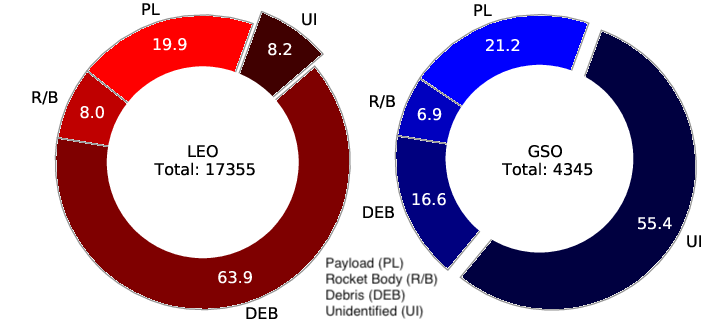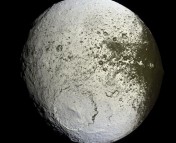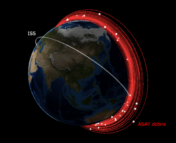Title: Looking out for a sustainable space
Authors: James A. Blake
First Author’s Institution: Department of Physics and Centre for Space Domain Awareness, University of Warwick, Coventry, UK
Status: Accepted to Astronomy & Geophysics (RAS Journals) [closed access]
Introduction: A problem in the sky
Imagine that every time you leave the house, instead of taking your trash to the dumpster, you just pile it outside your door. Depending on which door you use the most frequently, trash will rapidly fill up your passageway. If no one ever bothers to remove the trash, eventually all the doors will be blocked and you will have trapped yourself inside your house. You are probably smart enough to see why this is a silly way to live, but worse things are happening in space. Abandoned satellites and their fragments fly in orbit at high speed. The picture below shows what is orbiting the Earth as of January 2019. Each white dot represents one object, and the ones in what’s called low-Earth orbit (LEO) cover the entire Earth. The ring that is further out is the location of geo-stationary orbits (GSO), where the orbital period matches the rotation period of the Earth.

What’s wrong with having some stuff orbiting the Earth, you might ask? Like my trash analogy, the problem is that they block our way to space. Fragments as small as 10 cm can kill a satellite mission. Unlike my trash analogy, if enough space junk accumulates, they can produce more fragments on their own. Several bands of LEO are already at risk of what’s called a runaway collisional cascade. This happens when space junk collide with each other and fall apart, their fragments going on to seeding more collisions, generating more debris, and restarting the cycle. On the other hand, space debris in high altitude orbits (like GSO) don’t experience much atmospheric drag, and will stay up there for centuries.
From this you probably gathered that most of these debris are either abandoned satellites or their fragments. Even though these objects were originally launched by humans, cataloging and tracking them are a huge challenge.
What’s up there?
Since the first manmade satellite was launched in 1957, space agencies have been keeping track of bodies orbiting the Earth. By mass, 98% of those are satellites and rocket bodies, but we know very little about the remaining 2%, millions of small debris. These small debris elude radars and optical telescopes used in ground-based surveys, but they can still cause mission-fatal damage to a satellite. With limited data, NASA and ESA cannot accurately estimate the risk from orbital debris. Their models don’t even agree on the number of expected debris because there is no good observational constraint for very small fragments.

Fig. 2 shows a breakdown of what we do know about objects in LEO and GSO. In LEO (left panel) , the most numerous objects are debris. These come from fragmentation events, or “break-ups,” most commonly due to propulsion-related subsystems exploding. In other words, when leftover fuel gets heated up in space, it can blow the satellite to pieces. Other sources of debris include intentional anti-satellite tests (in which countries develop technology to destroy each other’s satellites) and a small number of accidental satellite collisions. In GSO (right panel), a large number of objects are “unknown” because GSO is significantly farther away from Earth and has historically received less attention.
To quote Dr. Blake, the author of today’s paper, “monitoring the mess of near-Earth space cannot solve the problem entirely, especially while the bulk of the dangerous debris population remains invisible and uncatalogued.” Now that I’ve alerted you to the grave danger we face, how do we make sure that future humanity can still go to space?
What can be done?
Like any environmental problem, the best solution is prevention. To prevent leftover fuel from exploding, satellite operators are now advised to “passivate” the spacecraft at the end of the mission. That means dumping out residual fuel and discharging batteries while they still control the spacecraft. The other safe disposal measures after the mission ends are to have the satellite re-enter the atmosphere or move into unused high-altitude orbits.
Even though these prevention measures are the best way forward, they are (un)surprisingly hard to enforce. The authors says, “despite an apparent consensus that [anti-satellite weapon] tests represent irresponsible and reckless behaviour, legally binding and internationally recognised regulations are still lacking.” The level of adherence to the above safety guidelines remain concerningly low.
Given that prevention is a “legal quagmire,” we can also try to remove debris that is already up there. Everything from harpoons to nets and tentacles have been used to collect orbital debris, but there’s no one-size-fits-all solution. Imagine how hard it is to capture metal shards tumbling at high speed without creating more debris.
Looking towards the future
Small satellites have flourished in recent years as LEO satellite constellations proved commercially lucrative. These satellites are not only a problem for astronomers but also a huge issue for the existing surveillance infrastructure. Dr. Blake says, “the problem is one that affects all operators in space, truly global in nature… [and] warrants a cross-sector, cross-disciplinary approach.” As astronomers, we can help society keep a watchful eye and ensure that the future of space flight is sustainable. If you want to learn more about space sustainability, Dr. Blake recommends the GNOSIS project.
Astrobite edited by Ciara Johnson
Featured image credit: NASA




